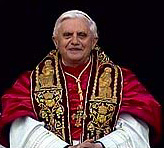

{HOME}
{ CONTACTS} {GIFT
SHOP} {MEDJUGORJE}
{ABOUT US} {APPARITIONS}
{DEVOTIONS} {SPONSORS}
{PICTURE GALLERY} {PICTURE
OF THE MONTH} {GOSPA'S
CORNER} {POW GROUP}
{PRAYER ROOM} {RESOURCES}
{WHAT'S NEW}
 Joseph
Ratzinger, Pope Benedict XVI
Joseph
Ratzinger, Pope Benedict XVIOverall
Joseph Ratzinger, now known as Pope Benedict XVI, was born of German decent in 1927. He entered into a seminary at a young age but was delayed because of World War II. However, in 1945 he re-entered, and was ordained a priest a few years later. He then received his doctrine in theology at age 30 and became known for being one of the top theologians in the Vatican.
Ratzinger had served over 20 years as John Paul II's Chief Theological Advisor, and in 1977 became cardinal by Pope Paul VI. April 19, 2005 Cardinal Joseph Ratzinger became the 265th pope, and being the first German pope in centuries. He is known now as Pope Benedict XVI, a name of Holy origin. Benedict is Latin for "Blessing."
Pope Benedict XVI, a conservative, has outlined his goals and made clear his pontificate would closely follow his predecessor Pope John Paul II. Benedict has said his primary task would be to work to reunify all Christians and that sentiment alone was not enough. "Concrete acts that enter souls and move consciences are needed," he said. His plans also include continuing an open and sincere dialogue with other religions.
Benedict, who is now 78, is the oldest elected pope and will skillfully lead the church through John Paul II's legacy.
Brief History
On November 25, 1981 John Paul II nominated Ratzinger as Prefect of the Congregation for the Doctrine of the Faith; President of the Biblical Commission and of the Pontifical International Theological Commission.
The office of the Prefect of the Congregation for the Doctrine of the Faith promotes and safeguards the Church's doctrine and defends Christian traditions in danger of new unacceptable doctrines."
New doctrine often time seems rooted in the concept of Modernism. Modernism is abhorrent to many traditionalists in the Church as it promotes a more secular role. The secular role lessens the dogma of the Church which stands as a foundation of the Doctrine of the Faith.
Traditionalists who see grave attempts to remodel the Church into a new age of Modernism can rest easy for now. The Dogma of the Church is protected as Pope Benedict XVI has a heart for tradition.
The Election
It was late in the first full day of a conclave when white smoke streamed from a chimney of the Sistine Chapel; shortly before 6 p.m. an estimated crowd of 20,000 in St. Peter's Square cheered. Within minutes, bells pealed in confirmation that a new Pope had been elected. About an hour later, Cardinal Jorge Arturo Medina Estevez of Chile heralded the news with the traditional Latin words "Habemus papam" -- "We have a pope."
Pope Benedict XVI emerged and spoke to those gathered in wait. "Dear brothers and sisters, after the great Pope John Paul II, the cardinals have elected me, a simple, humble worker in the Lord's vineyard," the new pontiff said, raising his arms to respond to the applause. "The fact that the Lord can work and act even with insufficient means consoles me, and above all, I entrust myself to your prayers."
Ratzinger & Medjugorje
Though Cardinals, Bishops, priests, religious and faithful are divided over the belief of the Marian apparition site of Medjugorje there is nothing to indicate any changes in the future with newly elected Benedict XVI. We know that John Paul II had a favorable response to Medjugorje, even though the first Commission set up to investigate Medjugorje did not.
On March 25, 1985, a letter from local Bishop Pavlo Zanic ordered the Medjugorje parish priests to cancel all pilgrimages, and to forbid the 6 young visionaries from gathering in the church or adjacent area. The gatherings were then transposed to the parish residence. In September 1987, Zanic forbid the apparition gatherings in the parish hall as well. Towards the end of 1986, Zanic traveled to Rome to inform the Congregation for the Doctrine of the Faith of his views on Medjugorje, but Cardinal Joseph Ratzinger, Prefect of the Congregation, transferred decisional authority to the Yugoslav Bishops' Conference.
A second Commission was appointed when it was discovered that the first was tainted. The first Commission was a group who had publicly announced they did not believe prior to their appointment to the Medjugorje Commission. However, due to political events the second Commission did not complete its findings. The question remains if the first Commission's findings therefore are the order of the day, or because the second Commission was disbanded without a finding, if the faithful have the right to continue to worship in Medjugorje.
Bishop Zanic for the rest of his life would remain an outspoken opponent of the Medjugorje apparitions. In fact he was so outspoken that Ratzinger forwarded a letter to the Yugoslav Bishops' Conference. The Conference of Bishops informed Zanic that Ratzinger said to stop his negative media blitz against the apparitions. Bishop Zanic did not respond to the Cardinal Ratzingers request and he continued to strongly stand opposed.
As the reader can see here, Medjugorje remains a controversial subject. For some it is a haven of Holy Ground and for others it is an embarrassment surrounded in disbelief. Regardless of the divisions, it does appear that Pope Benedict XVI views on Medjugorje are positive and open minded as were John Paul's.
In light of this Medjugorje USA article currently being posted on Spirit Daily please send emails to the info@medjugorjeusa. We are receiving many emails with questions on this article and Michael the webmaster of Medjugorje USA will respond to the questions. Thank you.
If you would like to write Medjugorje USA
 email:info@medjugorjeusa.org
email:info@medjugorjeusa.org